Servings: 12 soap bars
Cost: $15 - $40 / 12€ - 33€
Equipment
Ingredients
Lye Water
- 368 g distilled water
- 143 g lye (100% sodium hydroxide)
- 2 tsp sodium lactate or fine salt
Oils
- 325 g extra virgin olive oil
- 325 g refined or organic coconut oil
- 250 g RSPO palm oil
- 30 g castor oil
- 70 g sunflower oil
- 0.5 tsp french green clay
- 0.125 tsp ultramarine blue (CI 77007) optional
- 0.125 tsp green chromium oxide (CI 77288) optional
Add After Trace
- 8 drops grapefruit seed extract (GSE) (anti-oxidant)
- 30 ml essential oils blend optional
- alcohol or witch hazel to sprinkle recommended to avoid soda ash
Essential Oils Blend
Herbs for Decoration
- dried eucalyptus (in powder) optional
- dried rosemary (in powder) optional
Instructions
Get Ready!
- Wear goggles and gloves! Look at “Safety Precautions” in the video above or in Soap Making Safety Precautions
- Watch the video above about "Cold Process Soap Making Tutorial" or read the post Learn To Make Cold Process Soap for instructions on cold process soap making before starting. These are generic but important steps for all recipes.

- Assemble everything: ingredients, equipment, safety equipment. Prepare your workstations. Measure all the ingredients. Don’t start the recipe without having everything ready!
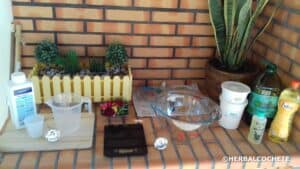
- Remove a tablespoon of the measured liquid oils into a small cup. Mix the green clay and mineral dyes with the oil and put aside.
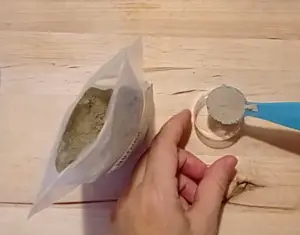
- Make sure you also prepare the dried herbs, they need to be ground into powder (use a coffee grinder). Only add dried herbs as powder.
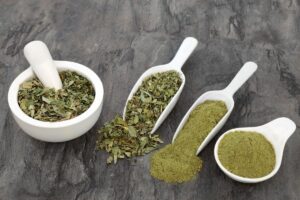
Heat the Oils
- Heat the oils until the solid oils are completely melted (it is not necessary to heat all the time). Add the dyes to the oils a mix with a spoon or spatula.
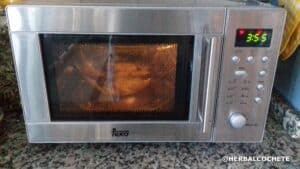
Make the Lye Water
- Make the lye water according to How To Make Lye Water. Add the sodium lactate to the water before making the lye water. Stir the mixture until the vapors start to dissipate.
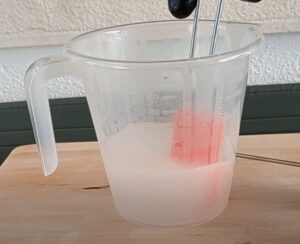
Make the Soap Batter
- Use as a target temperature 38ºC for the oil-solution mixture. If necessary, you can reheat the oils, but not the lye solution.
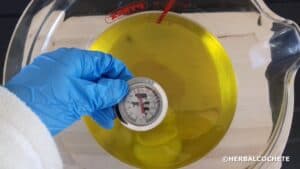
- Pour the lye water into the oils. It's better to strain the lye water to catch any undissolved lye crystals. Mix for a while.

- Add the colorant to the soap batter. Reach trace with the immersion blender.
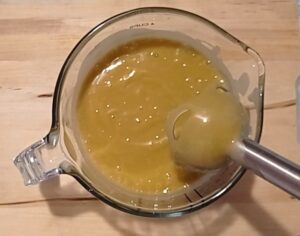
- Add the extract and essential oil (s) after tracing and stir with just a spoon. Add the dried herbs and stir well with a spoon.
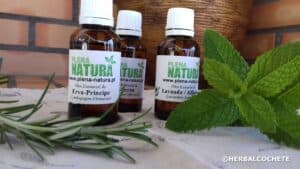
Molding and Curing
- Pour the dough into the loaf mold. If you wish, make some effects on the top of the dough with a spoon, spatula or fork (see video).
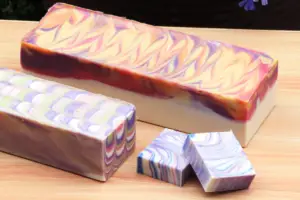
- Sprinkle the soap topping with witch hazel or isopropyl alcohol
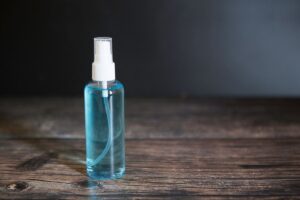
- Now you need to insulate the loaf mold, so that the soap gels uniformly. You can cover it all around with a blanket or a thick towel. You can also use your oven: pre-heat the oven with 40ºC. Turn it off then place the loaf mold inside. See chapter above "Using a Soap Loaf Mold" NOTE: this is not an optional step, if you don't insulate your loaf soap mold the soap will gel in the center and not in the extremities. You will get a dark round mark on your soap. However, if this happens, the soap is perfectly good to use, the problem is purely visual and nothing else.

- Let it set for 48 hours, always keeping an eye on the hardness of the soap. De-insulate it only when it's completely cold.
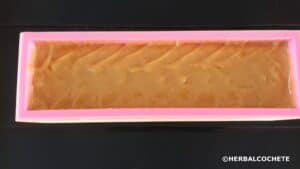
- Unmold the soap and cut it into bars. See How To Cure Soap, in the chapter "Unmoulding And Cutting Soap" for more detail on how to cut soap.
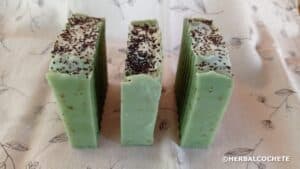
- Let the bars cure for 4 to 6 weeks. See How To Cure Soap.
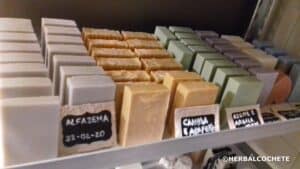
Video
Tried this recipe?Send a pic to @herbalcochete!
